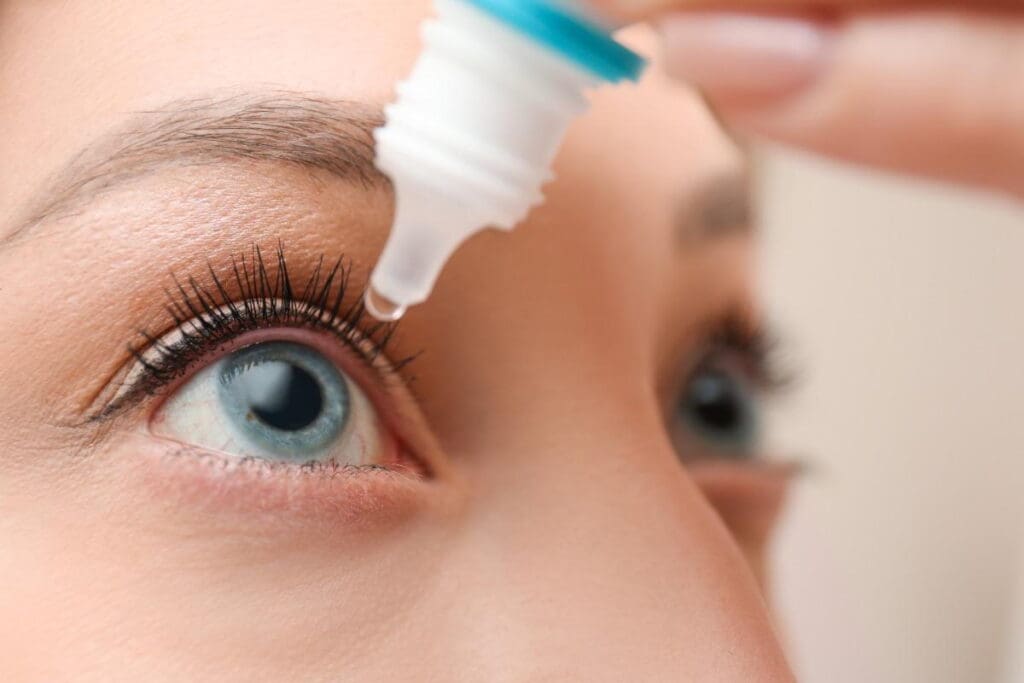
Dry eye is a common issue for many people, especially those who wear contact lenses.
Approximately 45 million people in the United States wear contact lenses, according to the Centers for Disease Control and Prevention (CDC). While contact lenses provide convenience and vision clarity, they can sometimes worsen dry eye symptoms.
Have you ever wondered why your eyes feel dry or uncomfortable after wearing contacts?
You are not alone!
Managing dry eye while wearing contacts is possible; you don’t have to stop wearing them altogether. If you’re experiencing dry eye while wearing contact lenses and are considering visiting your eye doctor ophthalmologist, this blog offers practical tips to help manage your dry eyes symptoms and treatment.
What is Dry Eye?
Dry eye happens when there is insufficient tear production, or the tears are of poor quality, failing to adequately lubricate the eyes. Tears are essential because they keep your eyes lubricated and comfortable. When the eyes lack proper moisture, it can lead to irritation, discomfort, and even vision problems.
There are two main types of dry eye:
- Aqueous tear-deficient dry eye: This occurs when the tear glands do not produce enough tears to keep the eyes moist.
- Evaporative dry eye: This occurs when tears are of poor quality, often because the eye’s meibomian glands do not produce enough of the lipid layer in the tears. Without this layer, tears evaporate quickly, leaving the eyes dry. Causes, Symptoms, and Risk Factors of Dry Eye
Causes
Many factors can cause dry eye, including:
- Damage to the tear glands
- Autoimmune diseases like Sjogren’s syndrome
- Certain medications, such as antihistamines or antidepressants
- Hormonal changes or menopause
- Allergies
- Wearing contact lenses for extended periods
Symptoms
- Common signs of dry eye when using contact lenses include: Stinging, burning, or itchy eyes Redness
- A gritty feeling in the eyes
- Blurred vision
- Excessive tearing (which may seem surprising but happens as a response to dryness)
Risk Factors
- Some factors increase the risk of developing dry eye, such as: Exposure to wind, low humidity, or air-conditioning
- Allergies
- Eye surgeries like LASIK or cataract surgery
- Age and gender (women are more prone due to hormonal changes)
How Do Contact Lenses Affect Dry Eye?
Wearing contact lenses can reduce the amount of oxygen reaching your eyes. This limited oxygen flow makes it harder for your eyes to produce tears, leading to dry eye. Contact lenses can also irritate the eyes if worn for too long or if they don’t fit correctly.
Here are some reasons why contacts may contribute to dry eye:
- Overuse: Wearing contacts for too long without breaks can reduce tear production.
- Improper prescription: Wearing the wrong contact lens prescription can cause strain and dryness.
- Poor fit: If your contacts are not the right size or shape, they may cause discomfort and dryness.
Tips for Alleviating Dry Eye Symptoms When Wearing Contact Lenses
Managing dry eye symptoms while wearing contact lenses is possible with the right steps. Here are four major areas to focus on:
1. Pick the Right Kind of Contact Lenses
Not all contact lenses are the same. Certain types permit more oxygen to reach your eyes, which helps alleviate dryness. These include:
Silicone hydrogel lenses: They allow five times more oxygen to pass through than regular lenses, making them ideal for people with dry eyes.
- Low water content lenses: These lenses help your eyes retain moisture and reduce dryness.
- Daily disposable lenses: These are used only once and help prevent overwearing, a common cause of dry eye.
- Scleral lenses: These cover the entire cornea, preventing moisture loss from the eye’s surface.
2. Use the Right Contact Solution
Sometimes, the solution you use to clean your contacts can irritate your eyes. Some solutions contain preservatives or chemicals that may trigger dry eye symptoms.
3. Practice Good Lens Hygiene
Proper hygiene can make a big difference in managing dry eye symptoms. Here are some best practices:
- Dispose of your contact lenses as recommended by your eye doctor or ophthalmologist.
- Change your contact lens case regularly to avoid bacteria buildup.
- Avoid wearing contacts when sick, as germs can easily transfer to your eyes.
4. Make Healthy Lifestyle Choices
Maintaining a healthy lifestyle can also help manage dry eye symptoms. Eating a balanced diet rich in vitamins like Lutein, Zeaxanthin, Vitamin A, and Omega-3 fatty acids can improve your eye health. Regular eye exams with an eye doctor or ophthalmologist are essential to ensure your lenses fit well and your eyes are healthy.
Additional Tips for Managing Dry Eye
Beyond the basics of choosing the right contact lenses and practicing good hygiene, consider the following tips to further alleviate dry eye symptoms:
- Use artificial tears: Rewetting drops designed for contact lens wearers can relieve dryness throughout the day.
- Limit wear time: If your eyes feel particularly dry, reduce how long you wear contacts daily.
- Avoid environmental triggers: Air conditioning, wind, and dry environments can worsen dry eyes. Use a humidifier at home or in your workspace to add moisture to the air.
Conclusion
It’s easy to overlook, but taking the right steps can make a huge difference. Though it can be challenging, especially if you rely on contact lenses for your vision needs, you don’t have to struggle alone!
An eye doctor or ophthalmologist can help you find the right contact lenses, solutions, and treatments to relieve your symptoms.
If you’re still unsure, contact us to schedule an appointment and get help from our dry eye professionals today.
**Please note that the information provided in this blog is intended for general informational purposes only and is not a substitute for professional medical advice. If you are experiencing dry eye symptoms or any other eye-related issues, it is essential to consult with a qualified eye care professional who can provide personalized advice, diagnosis, and treatment based on your individual needs.**

